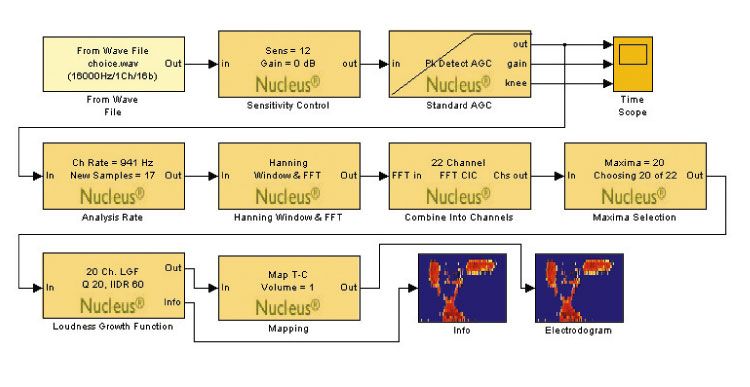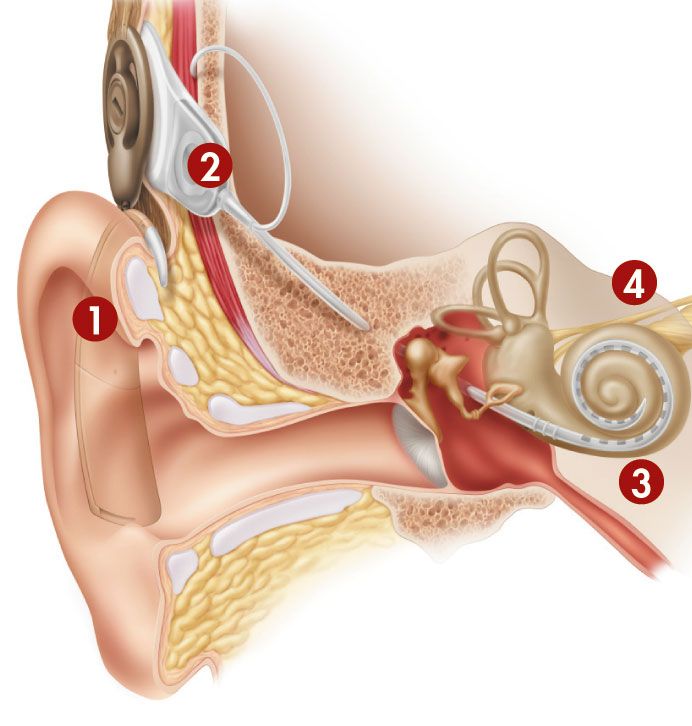The Sound of Innovation at Cochlear Limited
By Jack Wilber, MathWorks
A cochlear implant bypasses the damaged part of the ear, transmitting sound signals directly to the recipient’s auditory nerve. It is the only widely available medical device designed to restore a human sense.
Since releasing its first implant system more than 20 years ago, Cochlear has produced five generations of cochlear implants, each incorporating more features in ever smaller devices.
Engineers at Cochlear use MathWorks tools for Model-Based Design to accelerate development and prototype and test new ideas.
Improving the Hearing Experience
One way that engineers assess the effectiveness of new designs is to gather feedback from a Cochlear implant recipient within a specially equipped research laboratory environment—usually over multiple test sessions.
Developing new cochlear implant processing methods typically involves iterating implementations on a custom digital signal processor (Signal Processing) using assembler code. This time-consuming process results in development cycles that can last many years.
To overcome these limitations and test more new ideas, Cochlear decided to develop several rapid prototyping systems. Using MathWorks tools, they modeled and simulated the external speech processor of their Nucleus® 24 and Freedom™ implants, replacing all parts of the system except the implant itself with software. They could then rapidly create many different test cases by simply changing processing steps or parameters in software instead of developing a new product prototype for each test.
Creating a Development and Test Platform
Brett Swanson, senior DSP researcher at Cochlear, used MATLAB to create the Nucleus MATLAB Toolbox (NMT), a development and test platform that replicates the signals typically generated by custom application-specific integrated circuits (ASICs) inside the external speech processor. NMT interfaces to hardware that communicates with a recipient’s implant. It includes standard and proprietary signal processing algorithms that enable Cochlear engineers and researchers to quickly try out new designs and algorithm improvements.
Researchers around the world use NMT to create and play back stimuli for implant recipients, who perceive the stimuli as sounds. As researchers adjust the inputs, recipients comment on any improvement or worsening of sound quality. Researchers may also measure the recipients’ performance on a variety of objective speech tests to compare processing changes more objectively. They pretest some design changes, such as noise reduction algorithms to improve the signal-to-noise ratio in difficult listening environments by using MATLAB to examine and analyze output signals. This approach helps focus recipient testing by eliminating obvious problems first. Ultimately, however, the implant recipients themselves contribute significantly to the verification of all design changes to improve hearing performance.
While NMT has enabled numerous improvements to implant technology—for example, Cochlear’s proprietary SmartSound audio processing strategies— it is limited because it can play only preprocessed recorded sounds. During tests, a recipient hears the signals from NMT but cannot hear the researcher’s instructions or other sounds in the room.
Moving to a Real-Time Environment
To address the limitations of NMT, Cochlear sought a more advanced approach. "The next step was to make all the research-friendly features of NMT available in real time," says Michael Goorevich, principal DSP engineer at Cochlear. "That is when we started using Simulink and xPC Target."
Goorevich and his team developed a real-time research platform for developing sound- processing and speech-coding algorithms. Using Simulink, the group designed a custom framework and implemented Simulink blocks of commercially available algorithms from the Nucleus Freedom system. The framework includes standardized signal levels and data format specifications that enable the easy interchange of input, output, and signal processing blocks. The Simulink models are connected to the implant hardware using xPC Target.
"With Simulink and xPC Target everything is running live, so we can interact with the recipient. We can talk to them, they can hear us, and more importantly, they can hear how their own voice sounds," says Goorevich.
The new platform has many advantages over NMT. Engineers can implement speech-coding algorithms in a similar time frame as they had with NMT, but without having to write the custom DSP assembler code normally required for adequate real-time performance. Preprocessing of sounds is no longer required, enabling researchers to make decisions about input test material on the fly and to vary model parameters to control loudness, compression curves, and electrode levels during tests. The team plans to create a graphical user interface (GUI) in MATLAB that will enable recipients to control parameters themselves, further accelerating the test process.
Developing and Testing Product Improvements
Cochlear engineers use their new Simulink and xPC Target environment to develop and test a range of product improvements. Among these is a flexible method for extracting signal information from a fast Fourier transform (FFT ). In previous designs, Cochlear extracted frequency-domain energy in the speech processor via an FFT-based filter bank. The new design supports arbitrary cross-over frequencies between filters and new options for extracting the filter envelope. After successful testing with xPC Target on recipients, the design was implemented on the new Freedom speech processor for further testing in a clinical trial.
The new prototyping environment made it easy to test ideas—for example, it enabled the engineers to experiment with a new approach that involved extracting the envelope from the signal in each filter differently to produce enhanced temporal information.
"We really didn’t know if there would be any benefit to the new approach," Goorevich explains. "We made a small adjustment and implemented it using xPC Target, enabling the recipients to switch this new feature on and off." The team found a small but significant improvement in sound quality, as reported subjectively by the participants and observed in objective testing with speech test material.
Experimenting with Portable Systems
Currently, all recipient testing with NMT or xPC Target is conducted in a lab over several sessions. Goorevich and his team are investigating whether it would be feasible to develop a system that the recipient could take home. The portable system would include a DSP with signal processing code automatically generated with Real-Time Workshop. This approach would enable them to test product improvements in a real environment, improving the validity of the tests and reducing testing time.
Psychophysical Testing
Cochlear continues to explore advanced psychophysical testing. Engineers are using MATLAB in a system that stimulates the electrode array directly, bypassing the implant hardware that converts signals from the speech processor to stimuli. In these tests, complex pulse patterns are applied to individual or multiple electrodes in the array. Recipients report on the relative loudness or pitch of each perceived sound, enabling researchers to determine how loudness changes with amplitude and how pitch is affected by different electrodes. The goal is to find improved stimulation methods that can be incorporated into future implant designs.
"Without a good research platform, it’s impossible to test new approaches efficiently," conclude Goorevich and Swanson. "Using the platforms that we have developed—and continue to develop—we have the opportunity to rapidly try new ideas, features, and algorithms that will help people hear better."
How a Cochlear Implant Works
Unlike a traditional hearing aid, a cochlear implant does not amplify sound. Instead, it bypasses damaged hair cells in the ear and directly stimulates the hearing nerve in the inner ear, or cochlea.
- An external speech processor captures ambient sounds and converts them into digital signals.
- The signals are transmitted to an internal implant under the skin.
- The implant converts the signals into electrical impulses, which are sent to an electrode array inserted into the cochlea.
- The electrodes stimulate the auditory nerve, and the brain perceives signals as sound.
Published 2006 - 91421v00



